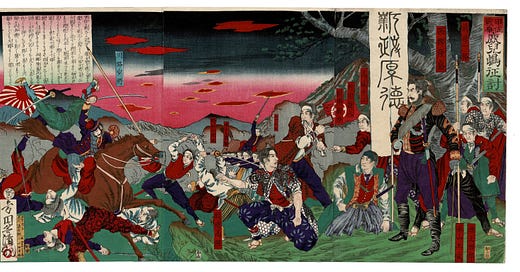The Violent Solution
Second Wave civilization spread across the world-conquering or dominating every society in its path.
The Second Wave encounters with First Wave societies resulted in a series of bloody wars and conflicts. The First Wave agricultural defenders failed against the Second Wave industrial future. The First and Second Wave clash was always the same as the First Wave society got swept away and usually annihilated. Second Wave modernization especially had no room for indigenous people.
In the United States, this clash began with the arrival of the first Europeans who created an agricultural, First Wave civilization, but with early Second Wave ideas. The white society pushed ruthlessly westward, as white farmers and settlers robbed the Native Americans of land and natural resources.
The agents of the Second Wave change were the early industrialists. They built factories and cities along the eastern seaboard of the United States. By the middle of the nineteenth century, the Northeast US became a powerhouse of industrial production with guns, timepieces, farm tools, textiles, telegraphs, and other goods. The rest of the continent was still ruled by agricultural interests. The American Civil War was primarily a result of the social and economic strains between First Wave and Second Wave forces. By 1861, it finally resulted in armed conflict.
The American Civil War was also fought over the moral issue of slavery because First Wave societies rely on human manual labor usually slaves or serfs. The Confederacy relied on the human labor of slaves. The war was also fought over a much bigger issue: would the rich American continent be governed by wealthy planters class or wealthy industrialists class, or First Wave or the Second Wave? Would the future American society be basically agricultural or industrial? When the Northern Union armies won, the issue was settled. The United States set its course on full industrialization and capitalism. From the American Civil War onward, all aspects of American life, economics, politics, social and cultural life, industrialism was dominant while agriculture took a backseat.
The same collision of civilizations erupted elsewhere as well. In Japan, starting in 1868, the Meiji Restoration repeated in distinctly Japanese conditions the similar battle between First Wave agricultural past and Second Wave industrial future. The ending of feudalism by 1876, and the ensuing Satsuma Samurai rebellion in 1877, their defeat, and the implementation of a Western-style constitution in 1889, were all manifestations of the confrontation of the First and Second Waves in Japan— steps on the road to Japan’s development as a world industrial power.
In Russia, the same collision between First and Second Wave forces erupted. The 1917 revolution and the ensuing Russian Civil War follow a familiar pattern. It was fought not primarily, as it seemed, over communism but the issue of industrialization. The Bolsheviks drove Second Wave change in Russia. The Bolsheviks under Lenin represented the urban industrial workers, and they sought to wipe out the final remnants of serfdom and feudal monarchy since they prioritized industrialism over agriculture. Although some socialists factions like the Socialists Revolutionaries were agrarian-based and opposed the Bolsheviks, Marxism just like Capitalism is a Second Wave concept. The Bolsheviks under Lenin and later Stalin formed a communist party highly supportive of the Second Wave, just like the western industrial capitalists.
In nation after nation, the collision between First Wave and Second Wave forces erupted into violence, causing rebellions, revolutions, and wars. By the middle of the twentieth century, First Wave forces were crushed, and the Second Wave civilization ruled over the earth.
Second Wave societies dominated the northern hemisphere by the late 20th century. In North America, over 300 million people live an industrial lifestyle. In Western Europe, a quarter of a billion humans live under industrialism. In Eastern Europe, the old Soviet Union and their Warsaw Pact Allies set up vast industrial enterprises — overseeing another quarter of a billion people. Finally, we come to the Asian industrial region, comprising Japan, Hong Kong, Singapore, Taiwan, and South Korea. Not only did they become an industrial Second Wave powerhouse of economic productivity, but they also provided cheap electronics helping to kick off the Third Wave. During this same period on the Chinese mainland, many experts missed China’s transition from an agrarian society to megalithic industrial power. As China entered the 21st century, it began to challenge the United States for world supremacy.
Despite vast diversity of language, culture, history, and politics— deeply held distinctions that wars are waged over them— all these Second Wave societies share familiar characteristics. Under the differences rests a relationship.
And to appreciate today’s crashing Third Wave change, we must be able to clearly recognize the parallel structures of all dying industrial nations— the hidden framework of what made Second Wave civilization successful. For it is this industrial structure itself that is now being destroyed.
In the 21st century, we often feel the influence of September 11th, 2001. Around the world, the same conflicts played out over and over. This is where Samuel P. Huntington and Bernard Lewis are wrong about the clash of civilizations. It is not an East versus West conflict or Muslim versus Christian, or capitalism and communism. It is a wave conflict encompassing civilization between the First, Second, and Third Waves. The emerging confrontation between China and the United States will be resolved by who most successful transitions to Third Wave civilization.



